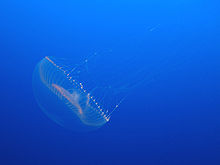Structural Biochemistry/Lipids/Techniques to Study Membranes/Fluorescence Photo Bleaching
Introduction
[edit | edit source]As briefly stated in a previous section on the fluid mosaic model of biological membranes, proteins and phospholipids diffuse both laterally and, to a lesser extent transversely, through the entire span of a membrane. This sort of behavior can be characterized by fluorescence microscopy. This particular technique is called FRAP or fluorescence recovery after photo bleaching. In a typical procedure, a specific portion of a cellular membrane is first tagged with a fluorescent chromophore. Next, an intense light is pulsed over a small part of the fluorescent-marked region and viewed under a microscope. As a result of the exposure to the powerful laser-light, the fluorescent molecules are bleached (destroyed). The bleached region is then monitored over time for the recovery of fluorescence (as neighboring unbleached molecules moving towards the bleached areas). This can determine the availability state of a protein - whether it is free to diffuse or is already bounded. The rate at which the recovery takes place, D, the diffusion coefficient, will reflect the overall mobility of membrane components. The equation for such observations is as follows where S is the average distance of movement per unit time (t) as they relate to the diffusion coefficient:
S = (4Dt)1/2

A typical speed for a membrane phospholipid is 2um per second. This may not sound very fast, however, if you take into account the relative length of a cell or organelles which are typically 2um or less, a phospholipid can easily traverse an entire surface in 1 second or less. This experiment also allows for comparison with other familiar materials where relative diffusion rates and viscosities are known. As it turns out, a membrane has a diffusion rate and viscosity similar to that observed in olive oil. The speeds for membrane proteins vary a great deal from nearly immobile to nearly as fast as a phospholipids. This should not be surprising being that proteins have, in general, a more irregular shape and a more uneven distribution of polar and nonpolar groups. Indeed, some of the more immobile proteins are anchored to various structures within the cell.
GFP
[edit | edit source]
GFP is a protein that exhibits a green florescent light when exposed to blue light, hence its name. Green florescent protein was the first protein extracted from A. Victoria. Other marine animals, mostly corals, also exhibit florescence. The color of the florescence’s varies based on the structure of the derivative.
GFP Uses
[edit | edit source]
GFP's can be used to study certain cell processes that could be difficult if not impossible to study. Including DNA replication and transcription, protein synthesis and transport, organelle and cytoskeleton assembly/disassembly, energy metabolism, and signal transduction pathways. Fluorescence is useful for measure cellular processes over time scales of minutes seconds or hours.. The most important aspect of GFP is it is genetically encoded by a single portable DNA sequence. This can be covalently bonded to a protein that can then be expressed in vivo.

FRET
[edit | edit source]
Florescence Resonance Energy Transfer has two major contributors. A donor chromophore and an acceptor chromophore. This allows for protein-protein interactions to be resolved spatially and temporally.The mechanism of fluorescence resonance energy transfer involves the use of a donor fluorophore. The fluorophore must be in an excited state. In the excited state the fluorophore may transfer its energy to a nearby acceptor chromophore. The main idea behind fret is that the energy transfer is based on the concept of treating an excited fluorophore as an continuously oscillating dipole. This can be compared to pair of tuning forks vibrating at the same frequency. Resonance energy transfer can yield a significant amount of structural information concerning the donor-acceptor pair.
The "phenomenon" of fluorescence resonance energy transfer is not regulated by photon emissions. FRET does not need the acceptor chromophore to be fluorescent either. The efficiency of the energy transfer varies in a direct proportion to the distance separating the acceptor and donor. FRET measurements can also be used as a ruler in molecular scale to determine distances between molecules. They must be labeled with an appropriate donor and acceptor fluorophore and must be within 10 nanometers of each other.
Credits
[edit | edit source]Lippincott-Schwartz J Annu Rev Biochem.2011 Jun 7 ; 80():327-32.
Berg, Jeremy, Tymoczko J., Stryer, L.(2012). Photobleaching Steps.Biochemistry(7th Edition). W.H. Freeman and Company. ISBN1-4292-2936-5
